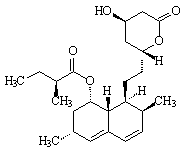Statin Science
Cholesterol is a fatty substance (lipid). It forms part of a group of biological substances called sterols, which are solid alcohols that, like all alcohols, can form esters with fatty acids. In plasma (a component of blood), most of the cholesterol is esterified, whereas in cells it is free. High cholesterol is also known by the medical term hyperlipidemia.
Statins work by inhibiting the enzyme 3-hydroxy-3-methylglutaryl coenzyme A (HMG-CoA) reductase, which is a major enzyme involved in synthesising cholesterol in the liver. This results in reduced cholesterol levels in liver cells, which then meet their cholesterol requirements by taking up cholesterol circulating in the blood, via a protein on the liver cell surface called an LDL receptor. LDL receptors break down the circulating cholesterol, which results in reduced levels of LDL cholesterol in the blood. Evidence exists to suggest that statins increase the number of liver cell LDL receptors.

Between 1978 and 1995, average total cholesterol levels among U.S. adults fell from 213 mg/dL to 203 mg/dL, and the prevalence of cholesterol of 240 mg/dL or higher declined from 26 percent to 19 percent. Moreover, congestive heart disease mortality continued to decline.
More on niacin for cholesterol control.
It is wrong to assume that drugs work solely because of their interaction with a specific receptor in the body. While that is important, other factors are also critical, including how fast the drug is absorbed into the tissue (called “uptake”), distribution of the medicine through the body (which can have both positive and negative effects), degradation or metabolism of the drug before it gets to the target receptors, rate of metabolism of the drug and its breakdown products, and how fast the drug is eliminated (either by removal through the kidneys or breakdown in the liver.) The first-pass through the liver destroys much of the statins; injections or transdermal administration is more efficient, but the cost of statins is low enough and the ease of pill form is compelling enough to keep this the dominant method of administration.
Hypercholesterinaemia (or just Hyperlipidemia) is a fancy medical name for high cholesterol in the blood. It is one of the major risk factors for atherosclerosis. Doctors prescribe statins to control hypercholesterinaemia.
Less than half the cholesterol in the bloodstream comes from diet. Most is made by the body - in particular by the liver. And that’s where statins work – by slowing or inhibiting cholesterol synthesis inside the liver. The statin molecules block an enzyme that assists in one of the 25 steps of making cholestero.
The Difference Between LDL and HDL
High-density lipoproteins (HDL) - sometimes called "good" cholesterol - reduce cholesterol's effects on blood vessels by carrying the cholesterol to the liver. It's a complex of protein and cholesterol. (Cholesterol is a lipid and a type of compound called a steroid.) The general benchmark for the target HDL is 40 mg/dl for men and 50 mg/dl for women. You want your level to be higher than this.
Low-density lipoproteins (LDL) - the bad cholesterol - is the stuff that builds up plaque on your blood vessels. The danger of LDLs depends partly on the levels of triglycerides in the blood. Typically LDL makes up 60-70% of total serum cholesterol.
In the bloodstream, lipids are transported in a protein coat. The density of the cholesterol inside the protein capsule affects whether the cholesterol contributes to plaque on the blood vessels and its influence on metabolism.
Gherlin and HDL
Gherlin plays an important role in the weight and hunger regulation systems in the body. It is sometimes called the "hunger hormone". Rising levels of gherlin tell the brain it needs to eat. Recent research shows gherlin levels also affect the blood serum levels of HDL. So feeling hungry regularly could help your cholesterol profile. Scientists also found that chemically blocking the melanocortin 4 receptor (MC4R) in mouse brains also raised HDL levels. This finding promises possible new drugs for cholesterol control in the future.
Osteoporosis and Statins
Recently it has been found that statins have bone anabolic activity and it has been suggested they could be employed for osteoporosis treatment. Statin usage is associated with higher bone mineral density. The most commonly used statins seem to activate the gene for bone morphogenic protein-2. This suggests that they promote bone growth. Indeed, experiments with animals show bone growth after statin administration. Analysis of the large JUPITER trials, however, found that statins did not have a significant impact on bone fracture risk.
Analysis of humans who have taken statins shows lower bone turnover, although no significant affect on bone density. The correlation between statin usage and bone fracture rates is unclear as studies have produced conflicting results.
There has also been some interesting work in rats using simvastatin to help bone heal after the insertion of titanium implants. Given the perpetual problems with bone implants, this is encouraging.
Organ Transplants and Statins
Potential immunologic effects of statins in cancer following transplantation.
Diannexin for organ transplants.
Other Diseases
Non-alcoholic fatty liver disease has been approached with treatment with statins. If statins end up being part of the treatment for this disease, it will be as part of a combination with other medicines.
A recent study showed statins have a hepatoprotective effect - that is, they help keep the liver from getting disease. The study was focued on cirrhosis and found that statins appear to slow the progressin of the disease. Earlier it had been feared that statins might make cirrhosis worse.
Use of cholesterol for therapy
Emerging roles for cholesterol and lipoproteins in lung disease.
Cholesterol: Friend Before Foe
Lasting Effects?
A remarkable British study found that giving female mice statins protected them from the effects of a high-fat diet, as well, incredibly, as their off-spring.
More work is needed to understand the cause of this phenomenon.


